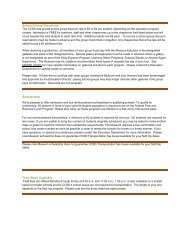wonderful things. - Las Vegas Natural History Museum
wonderful things. - Las Vegas Natural History Museum
wonderful things. - Las Vegas Natural History Museum
You also want an ePaper? Increase the reach of your titles
YUMPU automatically turns print PDFs into web optimized ePapers that Google loves.
In 2010, the <strong>Las</strong> <strong>Vegas</strong> <strong>Natural</strong> <strong>History</strong><br />
<strong>Museum</strong> proudly opened its newest<br />
permanent gallery, Treasures of Egypt. We<br />
tell Howard Carter’s story because it is<br />
now the <strong>Museum</strong>’s story as well. Treasures<br />
of Egypt re-creates Carter’s experience for<br />
visitors as they first peer into its wonders<br />
through a narrow opening in the wall.<br />
The most significant part of the display is<br />
comprised of carefully reproduced replicas,<br />
donated by the Luxor <strong>Las</strong> <strong>Vegas</strong> Hotel and<br />
Casino from its former King Tut’s Tomb<br />
<strong>Museum</strong>. All of the items were made in<br />
Egypt by Egyptian artisans, with the same<br />
materials and techniques used 3,000 years<br />
ago. Each item was approved by the Head of<br />
Egyptian Antiquities before being sent to<br />
<strong>Las</strong> <strong>Vegas</strong>, and the tomb contents are one<br />
of the only two reproductions sanctioned<br />
by the Egyptian government.<br />
Today, at least one of the statues –<br />
Tutankhamun standing on the back of a<br />
leopard – has become even more significant.<br />
The original piece on display at the renowned<br />
Egyptian <strong>Museum</strong> in Cairo was destroyed in<br />
the early 2011 uprising.<br />
Extending beyond the royal life of the<br />
pharaoh, visitors experience the daily life of<br />
ancient Egypt. A recreated Egyptian village<br />
and marketplace offers a hands-on encounter<br />
of day-to-day tasks such as gathering water,<br />
grinding wheat, making pottery, using ancient<br />
carpenter’s tools and bartering for food and<br />
supplies. The exhibit reveals this ancient<br />
culture’s dependence upon the Nile River<br />
and how its people thrived in the harsh<br />
desert environment.<br />
State-of-the-art technology shows the<br />
fascinating mummification process. In the<br />
first-time use of this technology in a museum<br />
setting, visitors slide a computerized panel over<br />
a replica mummy, to reveal CAT scan images.<br />
Two touch-screen experiences give a virtual tour<br />
of King Tut’s burial chamber, and a cruise on<br />
the Nile detailing life 3,000 years ago.<br />
Treasures of Egypt opened January 31,<br />
2010 in a building addition that enclosed<br />
a 5,000 square-foot outdoor patio. An<br />
appropriation from the 2007 State of Nevada<br />
Legislature funded the addition. Development<br />
of the exhibit was made possible by a<br />
generous donation from the Engelstad<br />
Family Foundation.<br />
The exhibit presents an ideal teaching and<br />
learning environment for a variety of subjects<br />
including geography, history, mathematics,<br />
science and technology. The new Ancient<br />
Egypt Experience introduces middle school<br />
students to this ancient world in guided gallery<br />
and lab sessions.<br />
For nearly two decades the <strong>Museum</strong> has<br />
maintained a steady rate of exhibit construction<br />
that supports its mission statement; 2010<br />
represented a banner year and has paved the<br />
way for continue growth.<br />
<br />
<br />
<br />
8<br />
<br />
<br />
9



